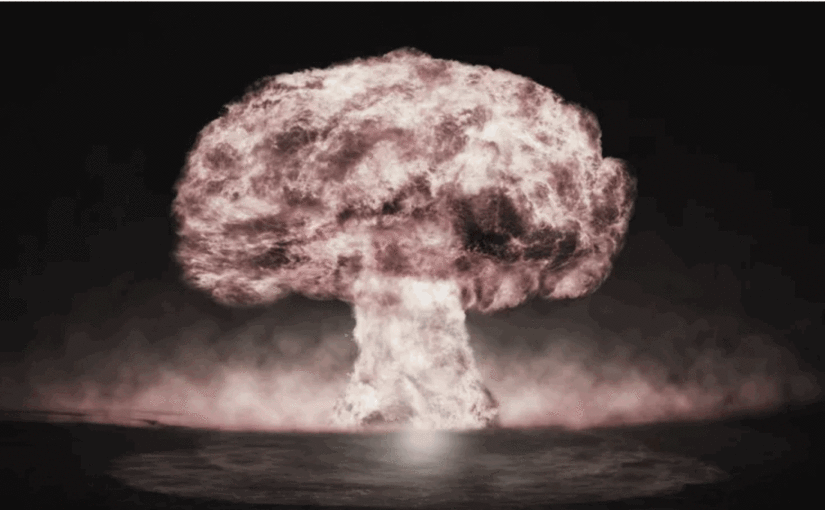Today, the American Navy has confronted and accepted the fierce reality that China has the “upper hand” in the South China Sea.
That China has established strong defensive positioning and capabilities.
And that America has spent it’s time and efforts in other areas and towards other objectives. Now it must face the fact that it’s military has some glaring holes in it’s offensive capabilities. And it is reluctantly admitting to this situation.
Up until just a few months ago the entire American military and the funding and development mechanism for it just ridiculed the idea that either China or Russia had any technology that could match that of the United States.
Their argument has been that America is superior in every way, that the American military is battle tested, and fully funded and staffed with fine well-trained American soldiers, and that the technologies involved are more than a match for anything that could possibly be fielded by either China or Russia.
America is a nation of Rambo’s they argue. America has a warrior culture. America is a policeman for freedom™ and democracy™.
Not true.
However, when you meet a moron, you just smile, and continue on your way…
Is it okay to criticize CCP on WeChat? I’m going to China next year and worried about if this will affect my study abroad.
As a foreigner living in China, I have a few thoughts:
First, welcome to China! You’ll probably hear that a lot, mostly from Chinese people. I’ve lived here for over seven years, and I still get it. It can be annoying, but the vast majority of Chinese people love their country and are both happy and proud to share it with you.
Second, don’t confuse the CPC (that’s the correct abbreviation for the Communist Party of China) and the government of the PRC (the People’s Republic of China). They are not one-and-the-same. The vast majority of CPC members joined in order to make life better for other people. A friend of mine, who lives in the city that I used to live in, is a CPC member, and he volunteered to help with health checks at the highway entrance into the city (that is not his job, mind you. He volunteers. His actual job is that he runs a little shop that sells alcohol and cigars). Along similar lines, there was a viral video that came out about a year ago of a group of people driving in the countryside of Xinjiang. Their car went off the road, and a herdsman and his friend helped push them back onto the road. When the people offered him some money, he refused. His Mandarin Chinese wasn’t very good, so to show why he refused, he opened his coat to reveal the CPC pin on his lapel, and everyone understood completely:
Third, there’s not much to complain about in China. Sure, it’s annoying when there are new blockages for VPNs, but it doesn’t usually last all that long, and it can be annoying to do nucleic acid tests for Covid so often (as of writing this, my city does them every other day. Just about a week ago, we were doing them every single day, but there was an outbreak a couple of weeks ago – thankfully, due to these measures, the outbreak resulted in only about 10 cases in a city of over one million people). Outside of those, and the annual health check required for the visa renewal (no food or drink beforehand means that I have to wake up early and can’t drink any coffee), there’s really nothing that I can think of to complain about.
Fourth, so long as you don’t break the law by doing something stupid, like taking drugs, there won’t be any problems.
The Ugly American
When will the West respect China?
Within ten years. I went on a visit to China last year. Most of what we are fed in the press about China in the UK is negative: human rights, Tienanmen Square, blocked Google, smog, Hong Kong democracy, dictatorship etc.
I arrived in Kunming, Yunnan expecting to find the sense of oppression I had experienced in eastern Europe in the late 1970s and to be struggling with pollution etc.
I walked around with my mouth open! No pollution, clean streets, no beggars/homeless, wide variety of independent shops and food outlets, moderate traffic, !!electric motorcycles!!, well run places to stay, delicious food (so much better than UK ‘Chinese takeaway), very little sexualisation of women (either clothes or depiction in adverts), everyone with a 15cm smartphone, great internet access, people hiring bikes with an app on their phone.
Where shall I stop?
Once the truth starts to filter to the general population, respect will grow.
Of course there will be resistance. We in the West cannot bear the idea that our version of ‘democracy’ is not the best for everyone. It will take us a while to understand the role of the Chinese Communist party and the benefits of a system like that.
Addition 1: We are told that China suppresses religion – but in Dali there is a three-sources temple in the town – Confucius, Tao, Buddha – and the Confucius Centre in the centre has been completely rebuilt in the last few years. On the outskirts there is the Guan Yin temple. Ordinary folk out shopping come in all the time to say a prayer etc. I sensed their genuinely spiritual experience.
Addition 2: I also realised why China was advancing so fast – they work steadily! Wherever I looked people seemed to be just ‘getting on with it’. I sensed this was a deep habit, centuries old in the population.
Addition 3: Dancing in the park! Amazing. Just a group of people with a music-system doing musical Tai Chi. Another small group playing instruments in the park. So unselfconscious. Just enjoying themselves.
Update 2020: My prediction is probably now wrong. A dark cloud has descended over China/West relations. There is a growing China-phobia in the UK. People with no knowledge of China, who, when I wrote this post 2 years ago, would have little to say about China, now are experts making cold-war-like statements.
I responded recently to a very good article by a Harvard professor warning against a new cold-war with China. I was immediately vilified by comment writers (as was the author), accusing me of being a Chinese troll, or perhaps the author of the article. Very disturbing.
The main driving force for this is that western commentators blame China for their COVID19 deaths because of the delay in reporting in Dec 2019. The very slow and inadequate responses by the UK, US and now Brazil and all the consequent deaths are blamed in China, not on the inadequate response.
China is not perfect, but the inaccurate picture I reported 2 years ago has been transformed into something more dangerous.
Tortang Giniling (Filipino Beef Omelette)
Tortang Giniling is a Filipino ground beef omelette. It is unique in that the omelette is made more like a fritter and is filled with lots of beef and veggies. It is a delicious recipe for breakfast or for a light lunch or snack.

Filipino Ground Beef Omelette
Tortang giniling is a simple Filipino omelette made with ground beef.
This omelette isn’t like your traditional omelette where the egg batter is cooked and folded around cheese and other fillings.
Rather, this Filipino omelette is made in more of a fritter style. The beef and vegetables for the filling are first sauteed and then transfered to a bowl. Once they have cooled slightly, they are mixed with beaten eggs.
This batter is then ladled onto your hot skillet in the same way you would ladle pancake batter onto a hot griddle, making small, roughly 3 inch, round omelette fritters.

What does “Tortang Giniling” mean?
“Torta” is a word that you find variations of used in many cultures (Spanish, for example, and a variant in the French “tarte”). It is used to describe a number of dishes, but it often refers to a flat cake, of sorts.
In the Philippines, a “torta” refers to an egg fritter, or omelette.
“Giniling” is the Tagalog (one of the major languages spoken in the Philipines) word for “ground meat”.
Tips for making Tortang Giniling
With all the vegetables and meat right inside this omelette, flipping it can get tricky if you use too large of a pan and let your batter spread over too large of an area.
That’s why we like to make these into pancake-sized omelettes (or fritters). (Roughly 3 inches in diameter.) This will make flipping these ground beef omelettes easier.
How To Serve Tortang Giniling
It is traditional to serve tortang giniling for breakfast with garlic fried rice and banana ketchup.
To those of us in the States, this sounds like a bit of an unusual breakfast, but if you like savory breakfast dishes, this is definitely worth a try.
If savory breakfasts aren’t your thing, this makes for a great lunch or snack as well!
Ingredients
- 1 Tbsp oil
- 1 onion, diced
- 3 cloves garlic, minced
- 1 tomato, diced
- 1 lb ground beef
- ½ tsp salt
- ¼ tsp ground black pepper
- ½ c peas
- 5 eggs, lightly beaten
- Vegetable or canola oil, for frying
Instructions
- In a large skillet, heat oil over medium high heat. Add the onion and garlic and saute until softened, 2-3 minutes.
- Add the diced tomato to the skillet and continue cooking for 5 minutes, letting the tomatoes release their juices.
- Add the ground beef to the vegetables and saute until browned, 5-7 minutes.
- Add the salt and pepper. Mix well. Taste the mixture and adjust the salt and pepper as desired.
- Transfer the mixture to a medium bowl. Add the peas and let the mixture cool slightly.
- Once the meat mixture has cooled, add the beaten eggs and mix well.
- Wipe out the skillet you used for the meat and heat a little oil in it, over medium heat. Reduce the heat to medium low and spoon ¼ c of the egg and beef mixture into the skillet, flatten the mixture and shape it roughly into a 3-4 inch patty. (Depending on the size of your skillet, you may be able to cook more than one omelette at a time. Just be careful not to overcrowd the pan, or flipping the omelettes will be difficult.)
- Cook the omelette for 2-3 minutes on the first side. (If your omelettes cook faster than this, your pan is too hot. Reduce the heat for the next batch.)
- Flip the omelette and cook for an additional 1-2 minutes on the second side, until golden.
- Transfer the omelette to a paper towel-lined plate and continue with the remaining batter. (Keeping the plate with the cooked omelettes in a very low oven will keep them warm until all are made.)
Black Hawk Down: Hostile streets
Military capabilities
The following article is part of a series of articles that argues that no military technology is going to negate a MAD-level nuclear response to American military action. MAD is an anachronism for Mutually Assured Destruction. No matter what the American leadership might want to believe, there is no such things as “reasonable” or “safe” nuclear weapons.
Use of any type of weapons against a major power will result in a very dangerous response.
Mutually assured destruction is a doctrine of military strategy and national security policy in which a full-scale use of nuclear weapons by two or more opposing sides would cause the complete annihilation of both the attacker and the defender. It is based on the theory of deterrence, which holds that the threat of using strong weapons against the enemy prevents the enemy's use of those same weapons. The strategy is a form of Nash equilibrium in which, once armed, neither side has any incentive to initiate a conflict or to disarm. -Wikipedia
And this needs to be said.
For President Joe Biden and the entire neocon cabal strongly believe that they can unleash military action against either, or both Russia and China and NOT trigger a MAD level response.
"Does being “ahead” have any practical meaning, however? Is there a genuine contest for advantage that translates into their gaining an upper hand in some sense or other? The clear answer is “NO!” It is strategically meaningless. Why? Because it in no way alters the logic of Mutual Assured Destruction."
This article is titled “Russia’s Lead Over the US in Hypersonic Weapons Gives them No Practical Strategic Advantage in Geopolitics” by Michael Brenner and found on Zerohedge. It was written Tue, Jan 21, 2020 and republished with very little editing. You can read the Comments on the site directly if that is your desire. I normally do not post “doom porn” from Zerohedge, but it does have good and meaty articles from time to time.
This is one of them. Enjoy.
Russia’s Lead Over the US in Hypersonic Weapons Gives them No Practical Strategic Advantage in Geopolitics
Deployment of Russia’s hyper-sonic missiles is causing heartburn in the West. Media headline the news as a dramatic breakthrough on a par with the first Sputnik. “Experts” are rushed into play like those self-styled pundits pronouncing when the initial exit polls appear on Election Day. Pentagon officials assure us that the United States is at the top of the nuclear game and able to respond to (if not exactly match) anything that the Russians can put out there.

Ninety eight percent of all this instant reaction is “fog-horning.” It simply signals that something big and important is out there even though we don’t have a clear picture of its actual shape or dimensions — or its significance. That’s normal. What counts is moving swiftly to the “searchlight” stage of close observation and hard thinking. Whether analysts, official or otherwise, get there is problematic. We’re out of practice when it comes to serious strategic appraisal. After all, we’ve been flailing about in Afghanistan for almost two decades with no realistic aim or evaluation of the chances of achieving it by whatever means at whatever cost. The disorientation on Syria is even greater. There, we haven’t as much as figured out who are the “bad guys” and who are the “good guys” — except for ISIS.
If you can’t differentiate friend from foe for want of rigorous strategic analysis, your actions are predictably erratic — little more than the expression of mental fibrillations. The same can be said for the rest of the Missile East.
The Washington consensus is sure about one thing: Russia is a mortal enemy. We sanction the Russians, we denounce the Russia, we coerce our European partners into ostracizing them, we conjure frightful images of Vladimir Putin while ignoring just about everything he says (as if they were Hitlerian rants). Still, no one seems able to provide a crisp formulation of what the Russian threat is — other than getting in our way in places where we demand to have full sway: Syria, Libya, Iran, Turkey, Ukraine, Georgia.
Of course, we also accuse them of working relentlessly to undermine American democracy. Yet, that remains debatable as does everything that bears the dubious label of “Washington consensus.” Anyway, whatever minuscule role the Kremlin might have in the accelerated unravelling of the American Republic, it barely registers amidst the hammer blows struck by the craziness of President Donald Trump, his enablers and a largely compromised, abject resistance.
Cold War Dread
Understandably, it is not that easy to overlook nuclear weapons. It wasn’t that long ago that many of us were tormented by the dread of a prospective Armageddon, when the Cold War carried manifest dangers, when the air was thick with hostility and menace.

In October 1962, Americans were terrified over Soviet missiles in Cuba, as this newspaper map showing distances between Cuba and major North American cities demonstrates.
Those acute fears gradually faded over the 40 years of the nuclearized Cold War. We came to live with the Bomb — if not to love it. Subsequently, concerns shifted to the risks associated with nuclear weapons proliferation among less stable states in more fraught places.
The reasons for this sedating were three-fold.
- Above all was the “balance of terror.’’ Leaders among the major nuclear powers absorbed the fundamental truth that not only was the notion of “winning” a nuclear war an oxymoron — but also that any use of nuclear weapons inexorably would escalate into acts of collective suicide. The survivors would envy the dead — as Nikita Khrushchev one said. That conviction became formalized in the doctrine of Mutually Assured Destruction.
- Second, it was reified by a number of treaties and understandings: START I,II (Strategic Arms Reduction Treaty), the Anti-BallisticMissile Treaty (ABMT), the Comprehensive Nuclear Test Ban Treaty, introduction of the Hot Line between the White House and the Kremlin, and the several arms reduction accords signed when Mikhail Gorbachev came to power in Moscow. Their collective purpose was to ensure that no conceivable advantage might be gained that would jeopardize — however slightly — the balance of nuclear power, i.e. the assurance that any resort to nuclear weapons was tantamount to the death of civilization.
- Finally, a number of technological developments reinforced Mutual Assured Destruction: the deployment of submarine launched ballistic missiles — SLBM (immune to location and possible destruction in a “first strike” — thereby, guaranteeing a retaliatory capability); improved controls that reduced the chances of an “accidental” or miscalculated launch; and the moratorium in placing ballistic missile defenses around major population centers that could have the effect of removing their “hostage” status.
The last has turned out to be a largely redundant measure since the strenuous efforts of the Pentagon/NASA as well as their Soviet/Russian counterparts to devise a workable BMD all have come up well short of producing anything meaningful.
U.S. President Gerald Ford and Soviet Premier Leonid Brezhnev sign joint communiqué to limit strategic offensive arms, 1974. (Wikimedia)
Unfortunately, two policy developments have awakened the nuclear issue from its somnambulant state. One is Washington’s abandonment of arms control treaties that were important parts of the nuclear stability package. George Bush removed us from the Comprehensive Test Ban Treaty(while observing its provisions), and effectively voided restrictions on ballistic missile defense in the vain hope of countering remote threats from prospective nuclear powers (Iran), bolstering the sense of security of some East Europeans (a non-solution to a non-problem)and – frankly – to get under the Russians’ skin. Barack Obama had neither the conviction nor political courage to reverse those retrograde moves.
Under Donald Trump, there has been a comprehensive plan to break free of all manner of restrictive commitments — military, diplomatic or economic. Deployment of regional BMD systems directed at Russian, Chinese and North Korean forces has been expanded despite their demonstrated efficiencies (one version could not even protect Saudi oil complexes or U.S. air bases in Iraq from primitive Iranian missiles).
Modernization of Nuclear Arsenals
The other troubling development concerns the modernization of nuclear arsenals by both the United States and Russia. President Barack Obama committed us to a trillion-dollar program to refine and upgrade American warheads and delivery systems over the next 20 years. The strategic rationale is obscure.
The Russian hypersonic missile development is a parallel development. In a purely technical sense, they obviously are “ahead” of us. And that irritates the hell out of the American security establishment.
Does being “ahead” have any practical meaning, however? Is there a genuine contest for advantage that translates into their gaining an upper hand in some sense or other? The clear answer is “NO!” It is strategically meaningless. Why? Because it in no way alters the logic of Mutual Assured Destruction.
Theoretically, there are only two imaginable ways to do that. The most significant would be development/deployment of a massive, truly effective BMD system that shields population centers and other critical, high value sites from retaliatory attack. That has shown itself to be impossible – even if the initiator of an attack succeeded in reducing the other side’s retaliatory forces by some significant fraction.
A totally disarming first strike in principle could be the second method logically to qualify MAD. It cannot be done, though.Fortunately. The combination of SLBMs, cruise missiles, and increased warhead lethality makes the idea of a disarming first strike a pipe dream of military strategists disengaged from reality. Hypersonic weapons do not change that calculus.
Accuracies of MIRVed warheads were lowered to 100 feet many years ago.(CEP, or Circular Error Probability = 50 percent chance of landing within radius.) Reducing that to 20 feet, therefore, is pointless – the silo is destroyed either way unless its missile has been “launched on warning” (tripwire automaticity as ultimate assurance of retaliatory strike). Similarly for missile defense.
Then, there is the question of an incoming missile’s speed. Current ICBMs that may give 18 minutes warning do not permit any defensive measures to be taken. If they arrive on target within six minutes, there is no additional benefit to the attacker. Today’s missiles that follow a straight trajectory cannot be intercepted — with or without their distracting decoys.
The fact that “swerve” capable hypersonic missiles can mambo their way to the target adds nothing to their effectiveness. Anyone who tells you that the Russians gain a strategic advantage thereby is lying — either in order to extract larger sums for R & D from the Treasury or to accentuate irrational fears of Russia.
President Vladimir Put visiting an exhibit of advanced weapons before meeting with Russia’s Defence Ministry Board, December 2019. (The Kremlin)
Finally, no reasonably sane leader would risk national suicide for a 1 percent chance of getting away with a first strike and surviving retaliation. There is no stake worth even contemplating it. Indeed, that logic holds even were there an impossible 50 percent chance of pulling it off.
Today, the United States and Russia are not engaged in a life-or-death struggle for world domination or for ideological vindication. Ascribing anything like that notion to Vladimir Putin is simply a sign of mental derangement – ours, not his. The same holds for the super-power competition between the United States and China.
So, if this line of reasoning is compelling, why did Russia’s leaders bother with investment of great sums to produce hyper-sonic missiles? The answer is a matter of speculation. Doubtless, technological and bureaucratic momentum has much to do with it. These sorts of long-term programs take on a life of their own — just as they do in Washington. The is no more reason for the United States to squander a trillion dollars in refining our nuclear arsenal as two successive administrations have committed us to doing.
In Russia’s case, there likely is another factor at work. Historically, Moscow leaders have exaggerated American technical capabilities; they have something of an inferiority complex on this score despite their own remarkable accomplishments. It is particularly acute in the nuclear realm — most especially in regard to ballistic missile defense.
This goes back to Nixon’s proposed Safeguard system, followed two decades later by Reagan’s Star War’s plans. Neither of which in actuality had the potential to alter the strategic balance. This free-floating strategic anxiety should be placed in historical perspective. There is a touch of paranoia in the Russian strategic mind — engraved by the events of the 20th century.
Some of this sentiment is conveyed by Putin’s remarks in announcing the deployment of hypersonic missiles: “We’re used to being in the position of catching up. That no longer is the case. Russia is the only country that has hypersonic weapons.”
To some unknowable degree these neuralgic points in the Russian psyche have been stimulated by the aggressive American program to surround Russia with BMD systems.
“Might it just be conceivable that the United States could perfect them, make it work, and somehow jeopardize the credibility of our nuclear deterrent? Why are they expending so much money and effort? Why do those BMD sites make Poland and the Baltics feel more secure when they are in fact militarily useless and it makes no sense for us to attack them?”
Informed analysis suggests that the answer is negative to all these questions. The alternative explanation: U.S. leaders are inclined to do feckless things; they are strategically obtuse.
The broader lesson is that there is truth to the old adage: “Russia never is as strong as it seems; Russia is never as weak as it seems.” We wrote it off as a world power in the 1990s and never since made the proper adjustment. That perception may have contributed to the glaring failure of the United States’ intelligence community in missing Russia’s remarkable break-throughs in weaponry.
It’s intelligence that counts more than Intelligence.
What are the implications of China’s Communist Party choosing Xi Jinping as its leader for life?
- He may be elected for another 5 year term. He is not “chosen for life”.
- He is the Titular head of the Country. He is the spokesperson and the Chinese People’s representative.
- As Commander-in-chief of the army he is not allowed declare war.
- Being party General Secretary, he is a very powerful figure.
- He does not RULE. As Chairman his role is consultative and decisions are taken by the Council, approved (or sometimes overruled) by the Chinese People’s Congress.
- I think a person should think and maybe study basic facts before formulating a question.
By the way FYI the CPC has about 2430 members, 847 of whom belong to 7 parties other than the CCP. Among the members of the Council there are at least 2 Senior Ministers who belong to parties other than the CCP.
As an aside, purely my own assessment, I get the impression that the main priority of each of the members of the Chinese People’s Congress is the welfare of the Chinese People.
Super 6-1 Shot Down
Quick and Easy Calzones Recipe
Quick and Easy Calzones filled with pepperoni, mozzarella cheese and marinara then topped with Italian seasoning and parmesan. Not only are these calzones so easy to make, but they taste absolutely amazing!

Quick and easy calzones is one of our family favorite, picky eater approved recipes that we can make fast on those busy weeknights. If you love a good homemade pizza recipe, then you are going to love this one!

This recipe is great because each person can pick their own toppings (if you want) and then there is no fighting about what is on the pizza! Or, you can make them all the same and serve it as an appetizer.
We have done it both ways, and either way is amazing. So, make sure you bookmark, pin, or save this recipe so you can find it quickly when you need an easy dinner recipe to make.
Ingredients Needed For Our Quick and Easy Calzones Recipe:
- Refrigerated pizza crust (your favorite kind)
- Marinara sauce
- Shredded mozzarella cheese
- Pepperoni slices
- Melted butter
- Italian seasoning
- Grated Parmesan cheese
How To Make Our Quick and Easy Calzones Recipe:
Begin by preheating your oven to 400 degrees fahrenheit.
Then, spray a baking sheet with nonstick cooking spray and set it aside.

Now, get out your refrigerated pizza crust and cut it into 6 equal squares (as best as you can).

Next, in the middle of each of the squares place about 2 tablespoons (or more if you like extra sauce), a little less than ¼ cup of shredded mozzarella cheese, and 4 pepperoni slices.
Take one corner of the square and fold it over to another corner to form a triangle.

Once you have formed a triangle around the calzone fillings, use a fork and go around the open sides and press it into the dough to seal it closed.
Next, place each of the filled calzones on the prepared baking sheet.

Using the melted butter, get out a pastry brush and spread some of the melted butter on top of each of the calzones and then sprinkle some of the italian seasoning and grated parmesan cheese on top.
Then place the baking sheet in the oven for 10-12 minutes and bake them until the tops are golden brown.

When they are done, take them out and serve them hot with warm pizza sauce for dipping!
Make the Dough Yourself
If you do not want to use refrigerated dough, you don’t have to! You can make homemade dough and use it in place of the refrigerated dough.
Sugar Spun Run has a great homemade pizza dough recipe that you can try with these delicious calzones!
Toppings You Can Try!
Mix up the toppings you use! You do not have to only use pepperoni. Use one topping, or multiple. Here are a few of our favorites:
- Green bell pepper
- Onion
- Mushrooms
- Sliced olives
- Red onions
- Ham
- Sausage
- Pineapple
- Bacon
- BBQ sauce instead of pizza sauce
There are so many options! Make sure you mix it up and try what you like on your pizza in your calzones!
Great scene from Black Hawk Down! “Get on that fifty!”
A final word
China is a fortress. There is no fucking way that anyone can operate a military and engage china. This is a reality that you all have to accept.


